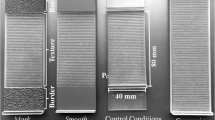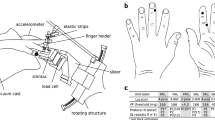Summary
The neural responses of 456 single units were recorded in parietal cortex of behaving monkeys during a haptic delayed matching-to-sample task. (1) In areas 2 and 5 together, 22% of the neurons were activated by the auditory cue that signalled the beginning of a trial. Virtually all of these cells were also activated during the arm movements required by the task. These neurons, showing both auditory-related and movement-related responses, may function in sensorimotor integration. (2) Responses related to arm projection frequently began before movement onset, sometimes as much as 320 ms before. Such “premovement” responses were approximately equally common, and showed the same latency distribution, in areas 2, 5a, and 5b. (3) There was a topographic rostral-to-caudal gradient of decreasing neural responsiveness to the animal's manipulation of the cue (sample) objects. Eleven percent of manipulation-activated cells responded preferentially to one of the sample objects. (4) Many cells showed sustained (> 3 s) activation during the delay period (the time between handling of the sample object and palpation of the choice objects), even though at that time the monkey was sitting quietly and without stimulation. (5) Cells with sustained activation throughout most or all of the 18-s delay period were rare in all areas tested except area 5a. These cells, especially those that were preferentially activated depending on which sample object was palpated, may function in the temporary retention of haptic attributes. (6) The population of cells activated during sample manipulation was largely distinct from the population of cells showing sustained activation during the delay period. These two cell populations may represent different but complementary aspects of haptic perception. (7) The most common response during the delay period was sustained inhibition. This may be an expression of a nonspecific mechanism for decreasing background noise and enhancing neural responses to an anticipated perceptual event. (8) Relatively little evidence was found to support a functional distinction between the neural response properties of areas 2 and 5 a. This suggests that area 2 may be at a higher level in the somatosensory heirarchy of the posterior parietal cortex than usually considered.
Similar content being viewed by others
References
Ashford JW, Coburn KL, Fuster JM (1985) The Elgiloy microelectrode: fabrication techniques and characteristics. J Neurosci Meth 14:247–252
Bauer RH, Steele TL (1985) Short-term memory for haptic cues in monkeys (Macaca mulatta). Anim Learn Behav 13:291–302
Bond HW, Ho P (1970) Solid miniature silver-silver chloride electrodes for chronic implantation. Electroencephalogr Clin Neurophysiol 28:206–208
Buser P, Bignall K (1967) Nonprimary sensory projections to the cat neocortex. Int Rev Neurobiol 10:111–158
Duffy FH, Burchfiel JL (1971) Somatosensory system: organizational hierarchy from single units in monkey area 5. Science 172:273–275
Evarts EV (1974) Precentral and postcentral cortical activity in association with visually triggered movement. J Neurophysiol 37:373–381
Fuster JM, Bauer RH, Jervey JP (1982) Cellular discharge in the dorsolateral prefrontal cortex of the monkey in cognitive tasks. Exp Neurol 77:679–694
Fuster JM, Jervey JP (1981) Inferotemporal neurons distinguish and retain behaviorally relevant features of visual stimuli. Science 212:952–955
Fuster JM, Jervey JP (1982) Neuronal firing in the inferotemporal cortex of the monkey in a visual memory task. J Neurosci 2:361–375
Galambos R, Myer RE, Sheatz GC (1961) Extralemniscal activation of auditory cortex in cats. Am J Physiol 200:23–28
Gellerman LW (1933) Chance orders of alternating stimuli in visual discrimination experiments. J Gen Psychol 42:206–208
Gibson JJ (1966) The senses considered as perceptual systems. Houghton Miffin Co, Boston
Gross CG (1973) Visual functions of inferotemporal cortex. In: Jung R (ed) Handbook of sensory physiology, Vol VII/ 3B. Springer, Berlin New York, pp 451–482
Hyvärinen J (1981) Regional distribution of functions in parietal association area 7 of the monkey. Brain Res 206:287–303
Hyvärinen J, Poranen A (1974) Function of the parietal associative area 7 as revealed from cellular discharges in alert monkeys. Brain 97:673–692
Iwamura Y, Tanaka M (1978) Postcentral neurons in hand region of area 2: their possible role in the form discrimination of tactile objects. Brain Res 150:662–666
Iwamura Y, Tanaka M, Sakamoto M, Hikosaka O (1985) Functional surface integration, submodality convergence, and tactile feature detection in area 2 of the monkey somatosensory cortex. Exp Brain Res Suppl 10:44–58
Jones EG, Powell TPS (1969) Connections of the somatic sensory cortex of the rhesus monkey. I. Ipsilateral cortical connections. Brain 92:477–502
Kaas JH (1983) What, if anything, is SI? Organization of first somatosensory area of cortex. Physiol Rev 63:206–231
Kalaska JF, Caminiti R, Georgopoulos AP (1983) Cortical mechanisms related to the direction of two-dimensional arm movements: relations in parietal area 5 and comparison with motor cortex. Exp Brain Res 51:247–260
Koch KW, Fuster JM (1985) Single unit activity in the parietal cortex of the primate during a haptic delayed matching-to sample task. Soc Neurosci Abstr 11:1275
Krieg WJ (1945) Cranio-cerebral topography of the monkey. Q Bull Northwestern Univ Med Sch 19:89–93
Mountcastle VB, Lynch JC, Georgopoulos A, Sakata H, Acuna C (1975) Posterior parietal association cortex of the monkey: command functions for operations within extrapersonal space. J Neurophysiol 38:871–908
Pandya DN, Seltzer B (1982) Intrinsic connections and architectonics of posterior parietal cortex in the rhesus monkey. J Comp Neurol 204:196–210
Pons TP, Garraghty PE, Cusick CG, Kaas JH (1985) The somatotopic organization of area 2 in macaque monkeys. J Comp Neurol 241:445–466
Randolph M, Semmes J (1974) Behavioral consequences of selective subtotal ablations in the postcentral gyrus of Macaca mulatta. Brain Res 70:55–70
Sakata H, Takaoka Y, Kawaraski A, Shibutani H (1973) Somatosensory properties of neurons in the superior parietal cortex (area 5) of the rhesus monkey. Brain Res 64:85–102
Seal J, Commenges D, Salamon R, Bioulac B (1983) A statistical method for the estimation of neuronal response latency and its functional interpretation. Brain Res 278:382–386
Seal J, Gross C, Bioulac B (1982) Activity of neurons in area 5 during a simple arm movement in monkeys before and after deafferentation of the trained limb. Brain Res 250:229–243
Seal J, Gross C, Doudet D, Bioulac B (1983) Instruction-related changes of neuronal activity in area 5 during a simple for earm movement in the monkey. Neurosci Lett 36:145–150
Author information
Authors and Affiliations
Rights and permissions
About this article
Cite this article
Koch, K.W., Fuster, J.M. Unit activity in monkey parietal cortex related to haptic perception and temporary memory. Exp Brain Res 76, 292–306 (1989). https://doi.org/10.1007/BF00247889
Received:
Accepted:
Issue Date:
DOI: https://doi.org/10.1007/BF00247889




